CURRENT AFFAIRS
Get the most updated and recent current affair content on Padhaikaro.com
National Awards of India
- Integrity Education, Delhi
- 17, Apr 2022
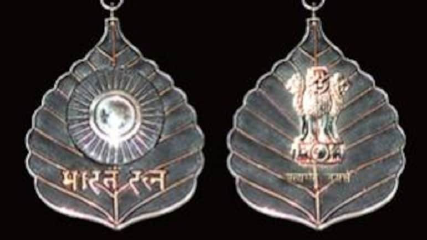
National Awards of India
India has several ‘National Awards’ across various categories. National awards of India under different categories such as civilian awards, gallantry awards, sports awards, cinema awards and literature awards.
Civilian Awards
The Bharat Ratna
It is India’s Highest Civilian Award which is conferred to people in recognition of their exceptional service in any field without distinction of race, occupation, position or sex. The recommendations are made by the Prime Minister of India to the President.
- On conferment of the award, the recipient receives a Sanad (certificate) signed by the President and a medallion. The award does not carry any monetary grant.
- It was first awarded in 1964 to Dr Sarvapalli Radhakrishnan, Dr. CV Raman and Chakravarti Rajagopalachari.
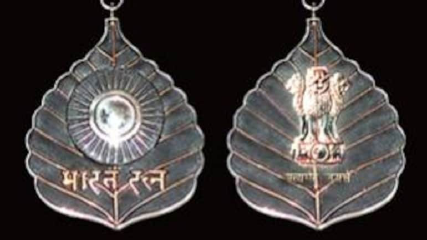
- The physical award is designed in the shape of a peepal leaf with ‘Bharat Ratna’ inscribed in Devanagri script under a sunburst figure.
- The reverse side of the award figurine features ‘Satyameva Jayate’ written in Hindi under an inscription of the state emblem.
- The emblem, the sun and the rim of the Bharat Ratna award are made of platinum while the inscriptions are in burnished bronze.
- It is approximately 59 mm long, 48 mm wide and 3.2 mm thick and has a white ribbon attached to it, so it can be worn as a medal.
- The awards are created at Alipore Mint, Kolkata along with the other prestigious national awards such as Padma Vibushan, Padma Bhushan, Padma Shri and Param Veer Chakra
Important Facts
- The award was started by former President Dr. Rajendra Prasad on January 2, 1954.
- The Bharat Ratna can also be awarded to non-Indians as there is no written rule against the same. Mother Teresa, a naturalised Indian citizen was conferred with the award in 1980.
- Non-Indians, Khan Abdul Ghaffar Khan (1987) and Nelson Mandela (1990) have also been awarded with the Bharat Ratna.
- As per Article 18(1) of the Indian Constitution, awardees cannot use 'Bharat Ratna' as a prefix or suffix to their name. However, they can add ‘Awarded Bharat Ratna by the President’ or ‘Recipient of Bharat Ratna Award’ in their bio-data, visiting card, letter head, etc.
- The award was not conferred posthumously at first but that criterion was changed in 1966.
- The youngest Bharat Ratna awardee and the first sportsperson to win the award was Sachin Tendulkar in 2014.
- A maximum of three Bharat Ratnas can be given each year. It was awarded to four people in the same year only once in 1999.
- In 1992, the government decided to award Subhas Chandra Bose with the Bharat Ratna. But the decision was criticised due to controversy about his death. That was the only time when the award was announced and later withdrawn.
- The Bharat Ratna ceremony is usually held at Rashtrapati Bhavan, New Delhi but a special ceremony was held at Brabourne Stadium, Mumbai to honour Dr D K Karve on his 100th birthday, 18 April 1958.
|
Recipient |
Year |
|
Pranab Mukherjee |
2019 |
|
Bhupen Hazarika* |
2019 |
|
Nanaji Deshmukh* |
2019 |
|
Madan Mohan Malaviya* |
2015 |
|
Atal Bihari Vajpayee |
2015 |
|
Sachin Tendulkar |
2014 |
|
CNR Rao |
2014 |
|
Pandit Bhimsen Joshi |
2008 |
|
Lata Dinanath Mangeshkar |
2001 |
|
Ustad Bismillah Khan |
2001 |
|
Prof Amartya Sen |
1999 |
|
Lokpriya Gopinath Bordoloi* |
1999 |
|
Loknayak Jayprakash Narayan* |
1999 |
|
Pandit Ravi Shankar |
1999 |
|
Chidambaram Subramaniam |
1998 |
|
Madurai Shanmukhavadivu Subbulakshmi |
1998 |
|
Dr Abul Pakir Jainulabdeen Abdul Kalam |
1997 |
|
Aruna Asaf Ali* |
1997 |
|
Gulzari Lal Nanda |
1997 |
|
Jehangir Ratanji Dadabhai Tata |
1992 |
|
Maulana Abul Kalam Azad* |
1992 |
|
Satyajit Ray |
1992 |
|
Morarji Ranchhodji Desai |
1991 |
|
Rajiv Gandhi* |
1991 |
|
Sardar Vallabhbhai Patel* |
1991 |
|
Dr Bhimrao Ramji Ambedkar* |
1990 |
|
Dr Nelson Rolihlahla Mandela |
1990 |
|
Marudur Gopalan Ramachandran* |
1988 |
|
Khan Abdul Ghaffar Khan |
1987 |
|
Acharya Vinoba Bhave* |
1983 |
|
Mother Teresa (Agnes Gonxha Bojaxhiu) |
1980 |
|
Kumaraswamy Kamraj* |
1976 |
|
Varahagiri Venkata Giri |
1975 |
|
Indira Gandhi |
1971 |
|
Lal Bahadur Shastri* |
1966 |
|
Dr Pandurang Vaman Kane |
1963 |
|
Dr Zakir Hussain |
1963 |
|
Dr Rajendra Prasad |
1962 |
|
Dr Bidhan Chandra Roy |
1961 |
|
Purushottam Das Tandon |
1961 |
|
Dr Dhonde Keshav Karve |
1958 |
|
Pt Govind Ballabh Pant |
1957 |
|
Dr Bhagwan Das |
1955 |
|
Jawaharlal Nehru |
1955 |
|
Dr Mokshagundam Vivesvaraya |
1955 |
|
Chakravarti Rajagopalachari |
1954 |
|
Dr Chandrasekhara Venkata Raman |
1954 |
|
Dr Sarvapalli Radhakrishnan (*Posthumously) |
1954 |
Padma Awards
The awards come after the rank of the Bharat Ratna and are awarded for distinguished and exceptional service in any field.
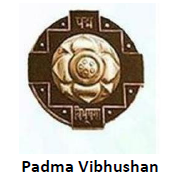
It is the second highest civilian honour of India is given for exceptional and distinguished service in any field including service rendered by the government servants. The award has a circular shape with a geometric pattern superimposed on the circle and is toned bronze. In the centre of the circle, a lotus flower is embossed. The word “Padma” and “Vibushan” are inscribed above and below the lotus flower in Devnagri Script. On the reverse side, it has the State Emblem and State Motto.
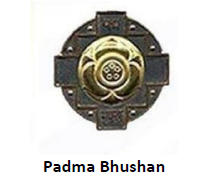
It is given to recognize distinguished service of a high order to the nation. The award has a similar design to the Padma Vibhushanand all the embossing is done in gold.
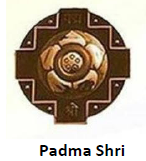
It is given by distinguished service in any field including service rendered by the Government servants. The shape of the award is the superimposition of a geometric pattern on the circle. The words "Padma” and “Shri” are embossed above and below the lotus flower in the centre. All the embossing is done in stainless steel and the periphery is furnished in bronze.
Various Fields of Work
As per the government the list of the fields which are considered for awards are-
- Art (includes Music, Painting, Sculpture, Photography, Cinema, Theatre etc.)
- Social work (includes social service, charitable service, contribution in community projects etc.)
- Public Affairs (includes Law, Public Life, Politics etc.)
- Science & Engineering (includes Space Engineering, Nuclear Science, Information Technology, Research & Development in Science & its allied subjects etc.)
- Trade & Industry (includes Banking, Economic Activities, Management, Promotion of Tourism, and Business etc.)
- Medicine (includes medical research, distinction/specialization in Ayurveda, Homeopathy, Sidhha, Allopathy, Naturopathy etc.)
- Literature & Education (includes Journalism, Teaching, Book composing, Literature, Poetry, Promotion of education, Promotion of literacy, Education Reforms etc.)
- Civil Service (includes distinction/excellence in administration etc. by Government Servants)
- Sports (includes popular Sports, Athletics, Adventure, Mountaineering, promotion of sports, Yoga etc.)
- Others (fields not covered above and may include propagation of Indian Culture, protection of Human Rights, Wild Life protection/conservation etc.
Eligibility for Awards
All persons without distinction of race, occupation, position or sex are eligible for these awards. However, except doctors and scientists, government servants including those working with PSUs, are not eligible for the Padma Awards.
Gallantry Awards
The gallantry awards are given upon conspicuous acts of bravery or valour or self-sacrifice in the presence of the enemy.
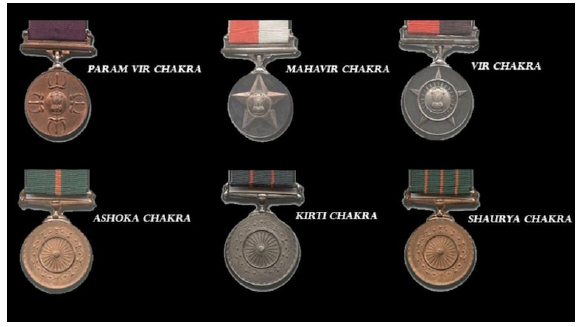
Facts about the Awards
- The first three awards in the category came into existence after independence are: Param Vir Chakra, Maha Vir Chakra, and Vir Chakra.
- The awards are conferred twice in a year - first on the Republic Day on January 26, and then on the Independence Day on August 15.
- The other three gallantry awards were introduced in 1952- Ashok Chakra Class I, Ashok Chakra Class II, Ashok Chakra Class III.
- Later, named as Ashok Chakra, Kirti Chakra and Shaurya Chakra.
- The President awards the gallantry awards to the awardees or their next of kins at the Defence Investiture Ceremony held every year at the Rashtrapati Bhawan.
- However, the Param Vir Chakra and the Ashoka Chakra are conferred by the President to the awardees on the occasion of the Republic Day Parade at the Rajpath.
Selection Process for Awards
- The gallantry Awards have a certain selection process for the recipients.
- In the case of Armed Forces, the award is initiated by the Unit.
- The recommended personnel names are sent to the Service Headquarters under the supervision of Commanders in the chain.
- The Awards Committee verifies the list and gets it approved by the Chiefs before sending the proposal to the Ministry Of Defence.
Param Vir Chakra: It is the highest order of recognition in the Military and is conferred to personnel who have performed a distinguished act of valour at the time of war.
- The name of the award is also referred to as the “Wheel of the Ultimate Brave”.
- The medal is a circular bronze disc and the ribbon is of plain purple colour.
- On the front, the National Emblem of India appears in the centre on a raised circle surrounded by four sets of the vajra.
- On the reverse, there are 2 inscribed legends separated by lotus flowers. The words “Param Vir Chakra” are written in Hindi and English.
Mahavir Chakra: It is the second-highest military honorary award in India, after the Param Vir Chakra, and is awarded for acts of conspicuous gallantry in the presence of the enemy, whether
on land, at sea or in the air. It replaced the British Distinguished Service Order (DSO).
- The medal is made of silver and is circular in shape. Embossed on the front is a five-pointed star with circular centre-piece on which the state emblem of India is inscribed.
- The words “Mahavira Chakra” are embossed in Devanagari and English on the reverse with two lotus flowers in the middle.
Vir Chakra: It is the third-highest honorary gallantry award in India and is conferred to personnel for acts of gallantry in the presence of the enemy on the battlefield.
- The medal is a circular silver medal.
- A five-pointed star, with the wheel or chakra in the centre, and, on this, the state emblem is inscribed.
- Around a plain centre, two legends separated by lotus flowers and “Vir Chakra” is embossed in Hindi and in English.
Ashoka Chakra: It is conferred to civilians or military personnel for most conspicuous bravery or some act of daring or pre-eminent act of valour or self-sacrifice away from the battlefield.
- The award design is circular in shape and “Ashok Chakra” is inscribed both in Hindi and English and these 2 versions are separated by 2 lotus flowers.
- This award is equivalent to the US Army’s peacetime Medal of Honour and the British George Cross.
Kirti Chakra: It is presented to the Indian military decoration awarded for valour, courageous action or self-sacrifice away from the field of battle and is awarded to civilians as well as military personnel.
- It is the peacetime equivalent of the Maha Vir Chakra and it comes in between Ashoka Chakra and Shaurya Chakra. Before 1967, the award was known as the Ashoka Chakra, Class II.
- It is circular in shape and is made of silver. The green ribbon is divided into three equal parts by two orange vertical lines.
- On the front, a replica of Ashoka Chakra in the centre is embossed and is surrounded by a lotus ring. On its reverse the words Kirti Chakra is embossed in both in Hindi and English; the versions being separated by two lotus flowers.
Shaurya Chakra: It is an Indian military decoration awarded for valour, courageous action or self-sacrifice while not engaged in direct action with the enemy.
- The award is circular in shape and is toned bronze. Green ribbon divided into four equal parts by three vertical lines.
- In the centre, words “Ashoka Chakra” is surrounded by a lotus wreath and an ornate edge.
- On the reverse, the words “Ashoka Chakra” is inscribed in Hindi along the upper edge on the medal and the same name in English along the lower rim.
Indian Cinema Awards
Dadasaheb Phalke Award
It is the only national award given in the field of cinema in India.
- Dadasaheb Phalke is known as the Father of Indian Cinema and thus, the highest National Film Award was named after him in 1969.
- The award is given to a film personality for their outstanding contribution to the growth and development of Indian cinema.
- It comprises of a Swarna Kamal, a cash prize of Rs. 10 lakh and a Shawl.
- Devika Rani Roerich was the first person to receive Dadasaheb Phalke Award in 1969.
- As of 2021, there have been 51 awardees. Among those, actor Prithviraj Kapoor (1971) and actor Vinod Khanna (2017) are the only posthumous recipients
Indian Literary Awards
Bharatiya Jnanpith Award
Instituted on 22nd May, 1961, the award is given for the best literary writing by an Indian citizen in a language listed in Eighth Schedule of the Indian Constitution.
- It carries a cash prize of Rs 11 lakh, a citation and a bronze replica of Vagdevi (Saraswati).
Sahitya Akademi Award
Every year since its inception in 1954, the prize is awarded for outstanding literary work and carries a cash prize of Rs 1 lakh.
- Sahitya Academi gives 22 awards each year for literary works in the languages which have recognised works.
- The first Awards were given in 1955.
Other National Awards
Gandhi Peace Prize
It was established on October 2, 1994, on the occasion of the 125th birthday anniversary of Mahatma Gandhi.
- The annual prize was instituted to encourage and promote the significance of Gandhian values over the world.
- It carries a cash prize of Rs 1 crore.
Indira Gandhi Prize for Peace, Disarmament and Development
The prestigious award was instituted in 1985 and has come to be regarded as a ‘Nobel’ over the years.
- It is awarded to those persons who have done outstanding work for international peace, disarmament and development.
Borlaug Award
The award was instituted in 1972 and named in honour of Nobel Laureate Norman E. Borlaug. The award is given to outstanding Indian scientists for their research and contributions in the field of agriculture and environment.
- It carries a cash prize of Rs 5 lakh, a gold medal and a citation.
National Sports Awards
The National Sports Awards of India comprise six different awards given to sportspersons of India by the Central Government.
- Major Dhyan Chand Khel Ratna
- Arjuna Award
- Dronacharya Award
- Major Dhyan Chand Award
- Maulana Abul Kalam Azad Trophy
- Rashtriya Khel Protsahan Puruskar